In today’s fast-paced world, customers expect a swift response to their queries. A HubSpot study confirms this and shows that 90% of customers expect an immediate response to their service questions. Several telephony features have emerged to improve customer response time and quality.
IVA (Intelligent Virtual Assistants) and IVR (Interactive Voice Response) systems are notable among them. They enhance your customer support quality, optimize workforce utilization, reduce customer wait times, and offer self-service; this is a must-read.
A lot of times, IVA and IVR are interchangeably used, and it gets challenging for businesses to choose between IVA vs IVR. Let us dive into the key differences between IVA and IVR in a contact center.
IVR helps achieve efficient call routing while IVA promotes self-service. IVR systems help enhance customer support quality, deliver quick responses, trim staffing costs, and optimize workforce utilization.
Though the best would be to use both the IVR and IVA, it might become unaffordable for small businesses. CallHippo offers a free IVR feature to help small businesses establish a professional identity and deliver seamless customer service. Get started with a free trial and explore its features!
What is IVR?
IVR (Interactive Voice Response) is an advanced telephony feature that helps route calls to the right agent based on their responses to a pre-defined menu. It uses text-to-speech technology and a DTMF (dual-tone multi-frequency) interface to read the inputs and responses from the callers and route them accordingly.
Based on the caller input, the IVR takes them to a live agent, voicemail, callback option, email, etc. Using IVR technology helps call centers and customer support teams streamline high-volume calls and minimizes customer wait times. It helps businesses offer 24/7 customer support and secure their trust. By directing incoming calls to the right agent, IVR system reduces the time spent on call transfers and increases the first-contact resolution rates.
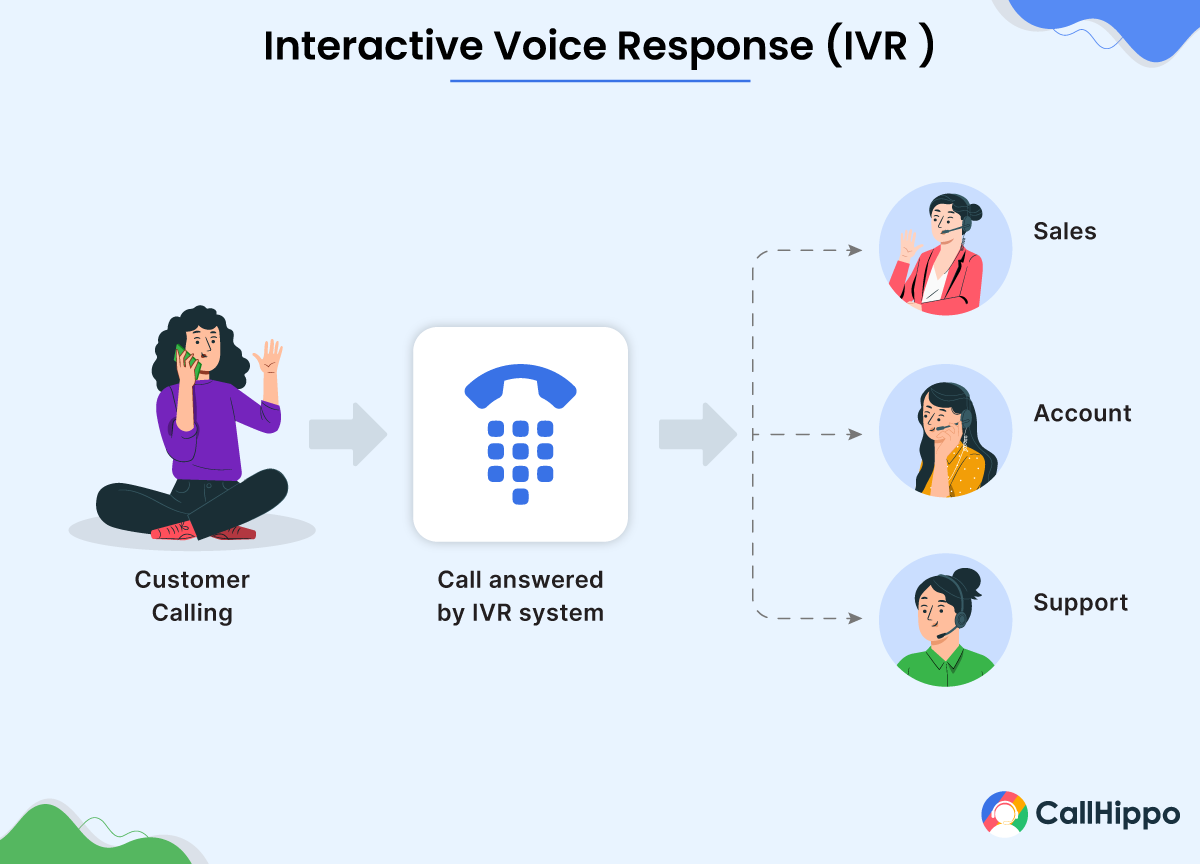
Traditional IVR systems use DTMF technology which requires customers to respond to the menu through the dial pad. Today, most systems use speech recognition and NLP (Natural Language Processing) to spot the keywords in customer responses and route them accordingly.
What is IVA?
IVA (Intelligent Virtual Assistant) is an AI-enabled self-service software that converses with customers like a human agent. They function like digital assistants and chatbots that can comprehend repetitive customer queries and offer appropriate responses. IVAs use machine learning, cognitive computing, and analytics to guide customers and offer automated responses.
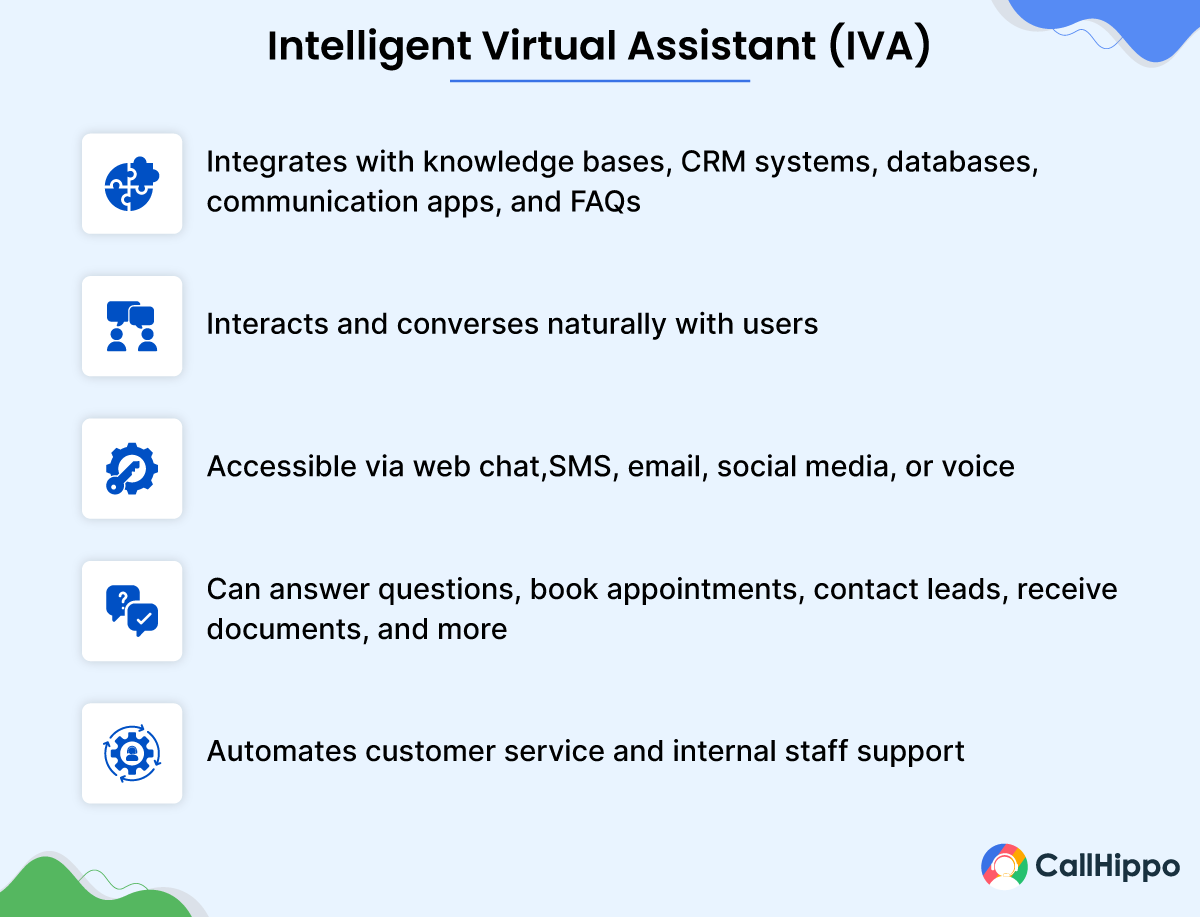
IVAs are dependent on CRM data, order history, and previous interactions to respond to a specific customer query. They use NLU (Natural Language understanding) to read customer responses and interact accordingly. The sophisticated IVAs are multilingual and can understand the customer’s natural credence better than IVRs.
A key point to make in IVA vs IVR is that the former intends to promote customer self-service while IVR aims to route the caller to the right agent. IVA helps businesses reduce average response time and call handling efficiencies. As IVA offers self-service abilities and sorts out repetitive queries on its own, human agents can focus on handling more critical questions. It increases agent productivity and reduces staffing costs for businesses.
How Does an IVR Work?
Now that you know what an IVR is, let us move ahead to understand how it works.
1. Caller interaction
When a caller reaches your number, the IVR system greets them and walks them through a menu. For instance, an IVR prompt may be like, “For order information, say 1; For new inquiries, say 2; For delivery-related questions, say 3; To speak to a live agent, say 4”.
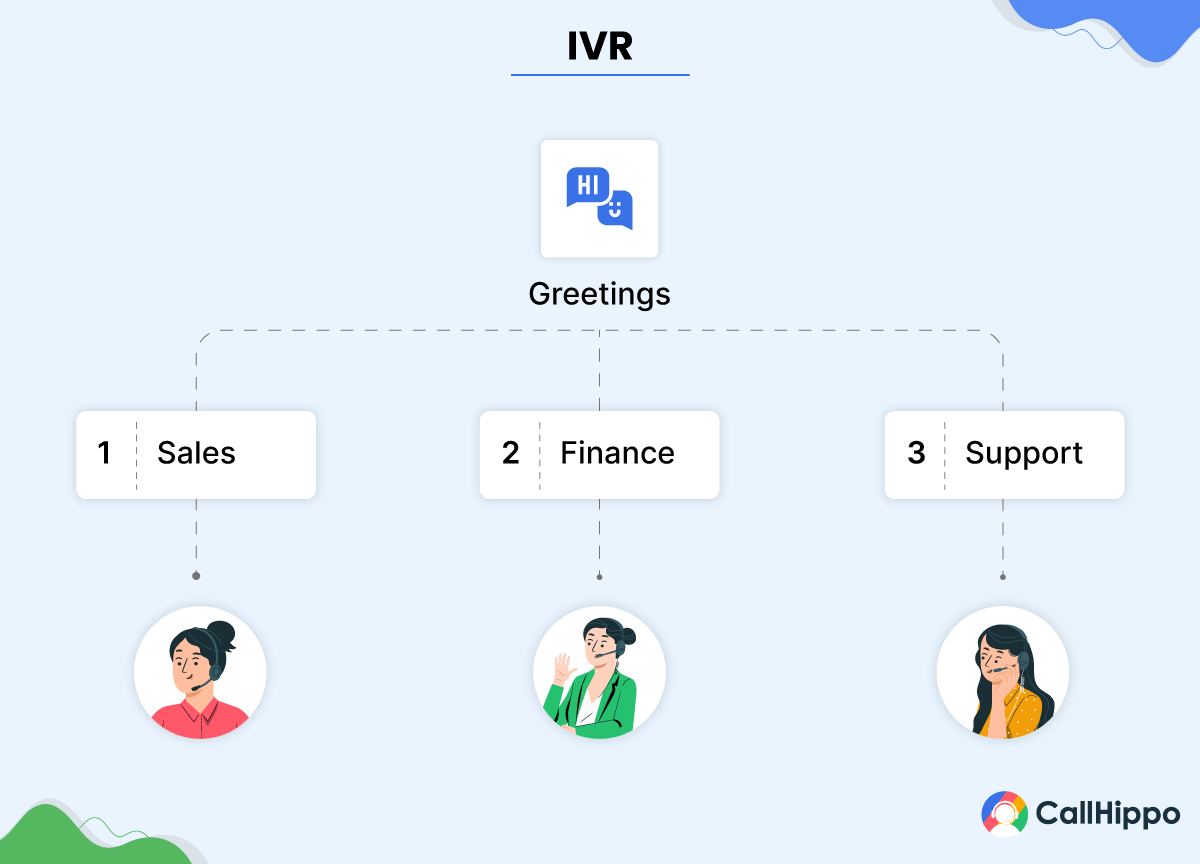
Most advanced IVR software tools allow you to add sub-menu options. When a customer responds with a 1, the sub-menu can be, “For hotel-related bookings, say 1; For flight-related bookings, say 2”.
2. Input recognition
Traditionally, IVR systems relied on DTMF (dual-tone multi-frequency) signaling to read the input from the caller. The technology allows customers to respond via touch tones on the phone keypad.
Modern IVR systems have advanced speech recognition abilities that allow callers to respond via their voice. The IVR leverages Natural Language Processing (NLP) to read customer responses and route the caller accordingly.
3. Call routing and navigation
Based on the input from the caller, the IVR routes them to the right department, or a specific agent, or places them in a queue. In case of long queues, the IVR allows callers to send voicemail or request callback options. It does the same when a caller reaches the contact centers outside business hours.
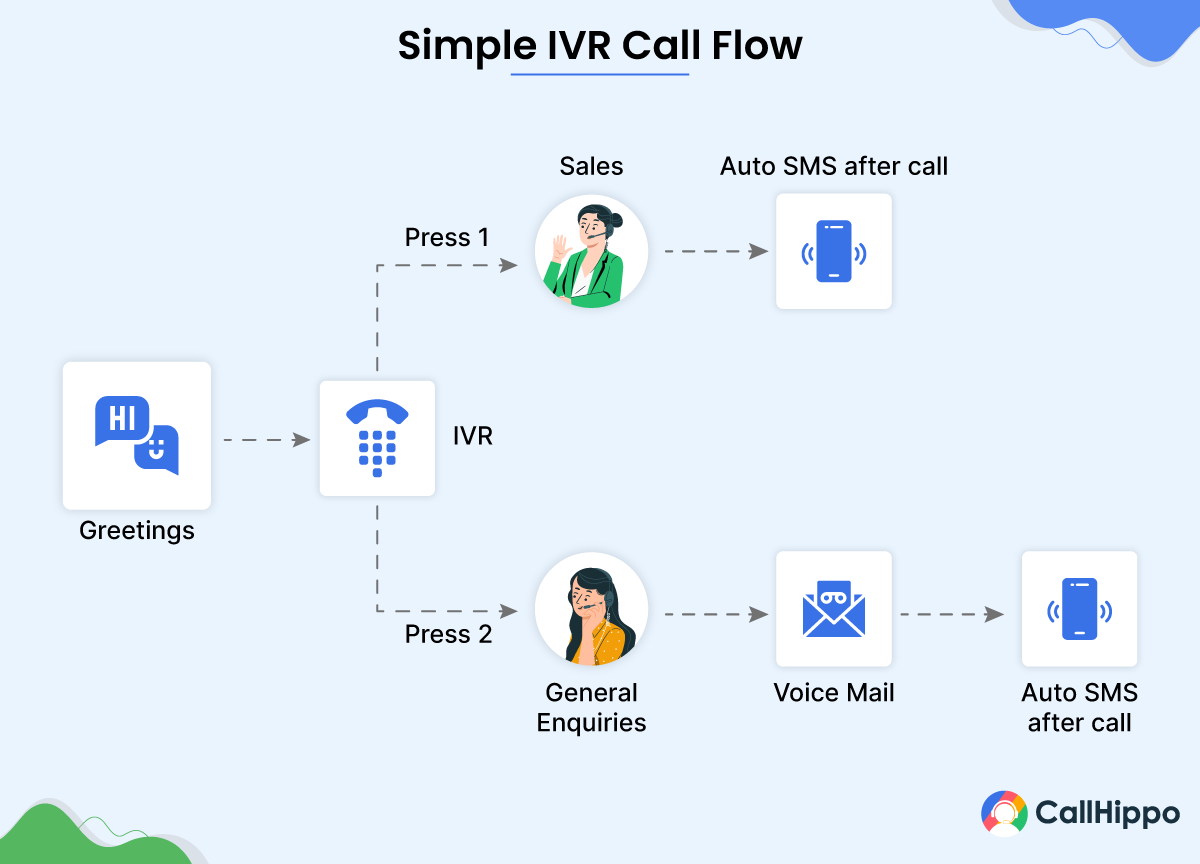
Advanced IVR systems are integrated with data to enable them to offer self-service to basic customer queries.
4. Error handling
There are chances that the caller might not comprehend the IVR menu correctly at their first instance. When there is an error or no input, you must give them options to choose between the following.
- Go back to the main menu
- Repeat the same menu
- Option to directly connect with the live agent
How Does an IVA Work?
A key point in IVA vs IVR is that the IVA has conversational abilities. Intelligent Virtual Assistants consume the caller’s response, read the intent, pull data from CRM and applications, and then deliver appropriate responses.
1. Caller input recognition
IVA uses natural language understanding (NLU) to read customer responses in the form of text or voice. The NLU helps transcribe customer input. Customer interaction may happen on a website, live chat tool, voice call, or mobile application.
NLU processes raw customer input into data and points that the IVA can then take up. Sophisticated IVA tools can read customer inputs in multiple languages and dialects.
2. Identify key intent
Once the NLU transcribes the caller input, the IVA uses Artificial Intelligence to identify the keywords, caller sentiment, main topic, etc. For instance, if a caller says, “I am looking to cancel a flight that I have booked already,” the IVA reads the keywords, “cancel”, “flight”, and “booked”. The virtual assistant tries to understand the caller’s intent from the keywords.
In case the IVA is not able to fully derive the intent, it throws a follow-up question.
3. Leverage CRM data
Based on the keywords and inputs from the previous step, the IVAs scan for data from the CRM database and other integrated software applications like order management tools, inventory management software, knowledge base, and accounting tools.
Based on the data, the IVA delivers an appropriate response to frequently asked questions and basic information requests. IVAs learn from responses and improve their accuracy with time.
Difference Between IVA vs IVR
While we know how IVA and IVR work, let us explore the differences between IVA vs IVR. Here is a summary.
| Parameter | IVA | IVR |
| Objective | Customer self-service | Efficient call routing |
| Self-service abilities | High | Limited |
| Degree of personalization | High as IVA tailors the response based on caller intent | Limited as IVR work based on a pre-defined menu |
| Database integration | CRM, knowledge database, order management portals, etc | Limited database integration as the intent is to achieve call routing. |
| Customer request handling | Handles complex queries | Navigate the caller to the agent in case of complex requests |
| Technological abilities | Uses AI, ML, cognitive computing, NLU, etc. | Uses NLP, DTMF, and speech recognition technology |
| Nature of interaction | Conversational, human-like | Robotic as IVR uses a pre-recorded menu |
| Learning abilities | High as it learns with time and enhances its accuracy | Limited. Requires frequent upgradation |
1. Self-service vs call routing
The main difference between IVA vs IVR is that IVA aims to enhance self-service abilities while IVR intends to achieve efficient call routing. IVAs are much more advanced than IVRs as they aim to comprehend customer queries and respond to them with relevant information. On the other hand, IVRs aim to route the incoming caller to the right agent, voicemail, queue, etc.
2. Personalized response
IVA aims to read caller intent and offer a personalized response to a specific query. On the other hand, IVRs have a common menu irrespective of the nature of the customer query. It cannot tailor the menu to cater to a customer’s specific intent. This is a notable difference between IVA vs.IVR.
3. Database integration
Another notable difference between IVA vs.IVR is database integration. IVA is integrated with the knowledge base, CRM database, order management portal, etc. This helps IVA fetch appropriate responses to customer queries.
On the other hand, IVRs are not integrated with databases and knowledge sources to a major extent. This is because they intend to achieve efficient call routing and not self-service.
4. Customer request handling
IVAs can handle complex customer queries, whereas IVRs cannot handle such detailed requests. As IVAs are integrated with databases and information, they can deliver appropriate responses to complex support requests.
5. Technological abilities
IVAs in a contact center are equipped with sophisticated technologies like AI, cognitive computing, and machine learning abilities to be able to comprehend customer queries. It uses NLU (natural language understanding) to understand caller requests in different slang.
On the other hand, IVRs leverage DTMF and speech-recognition abilities to read customer responses and direct them to the appropriate department or agent. This is a major point to make when it comes to IVA vs IVR.
6. Nature of interaction
The nature of interaction also differs significantly between IVR and IVA. While IVA engages with customers in a human-like, conversational tone, IVR uses a pre-recorded menu with DTMF and voice prompts.
7. Learning and adaptability
IVAs have machine-learning abilities that help them learn from repeated customer interactions and evolve with time. They improve the accuracy on their own. On the other hand, IVRs are static and demand manual upgrades for accuracy enhancements.
Benefits of Using IVR
From enhancing agent productivity to helping businesses build a professional identity, IVR software offers a wide range of benefits to businesses.
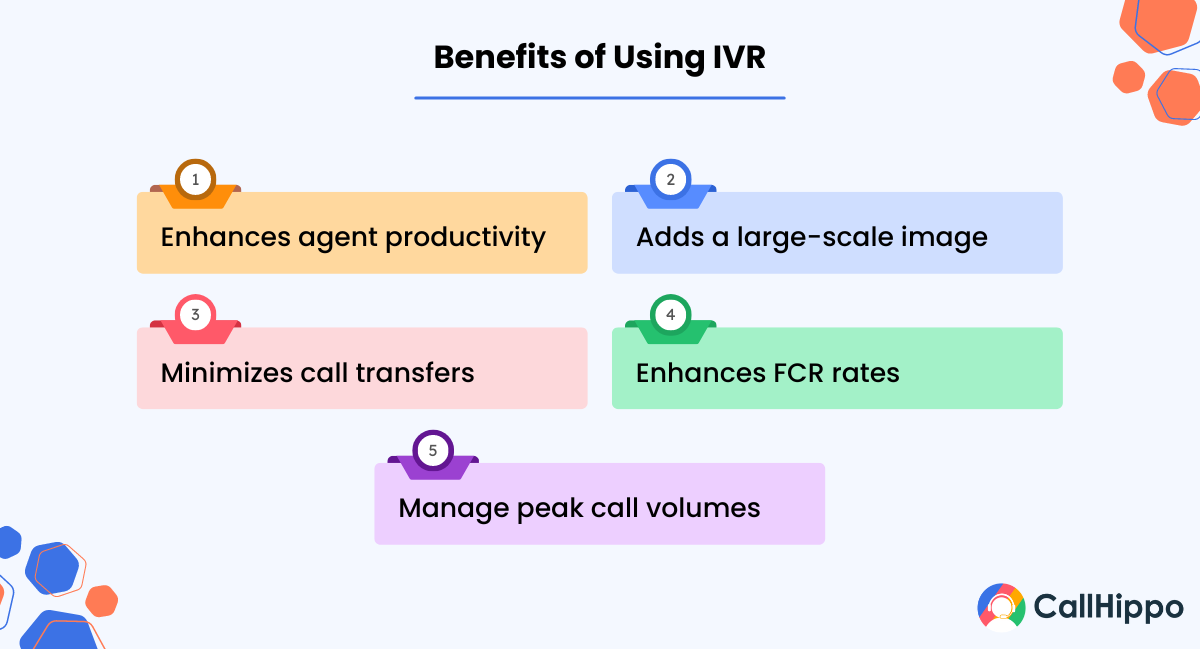
1. Enhances agent productivity
IVR system automates call routing based on customer responses to a pre-recorded menu. This helps agents shift their focus from administrative tasks to delivering efficient customer service and handling more critical queries. This helps maximize agent productivity and saves them from burnout.
2. Adds a large-scale image
A lot of people associate IVRs with corporations and large-scale enterprises. So, navigating the caller through the IVR software helps add a large-scale image and professional identity to your business. This boosts your reputation in the industry and helps secure customer trust.
3. Minimizes call transfers
IVR technology helps achieve efficient call routing. It helps transfer incoming calls to an appropriate agent based on customer responses and preferences. This helps minimize internal call transfers and saves time and effort. It also weeds off customer frustration that results from multiple transfers and repeating the information every time.
4. Enhances first contact resolution rates
With efficient call routing, it is more likely that the caller gets routed to the most capable agent in the shortest possible route. This helps minimize escalation and improve first-contact resolution rates.
5. Manage peak call volumes
IVRs help handle peak call volumes with ease. As they promote efficient routing, IVR systems help reduce the time spent on call routing. Also, IVRs help greet all incoming callers, which in turn acknowledges that the company is committed to customer service. IVRs can be customized to offer multiple options, like call back or voicemail, to customers during long queues. This helps reduce customer frustration from long waiting times while also helping businesses manage peak call volumes effectively.
You May Also Read : The Best Open Source and Free IVR Software
Benefits of Using IVA
IVA in a call center help businesses deliver personalized customer service, build 24/7 availability, reduce customer wait times, and help lower business costs. Let us look at each of them in detail.
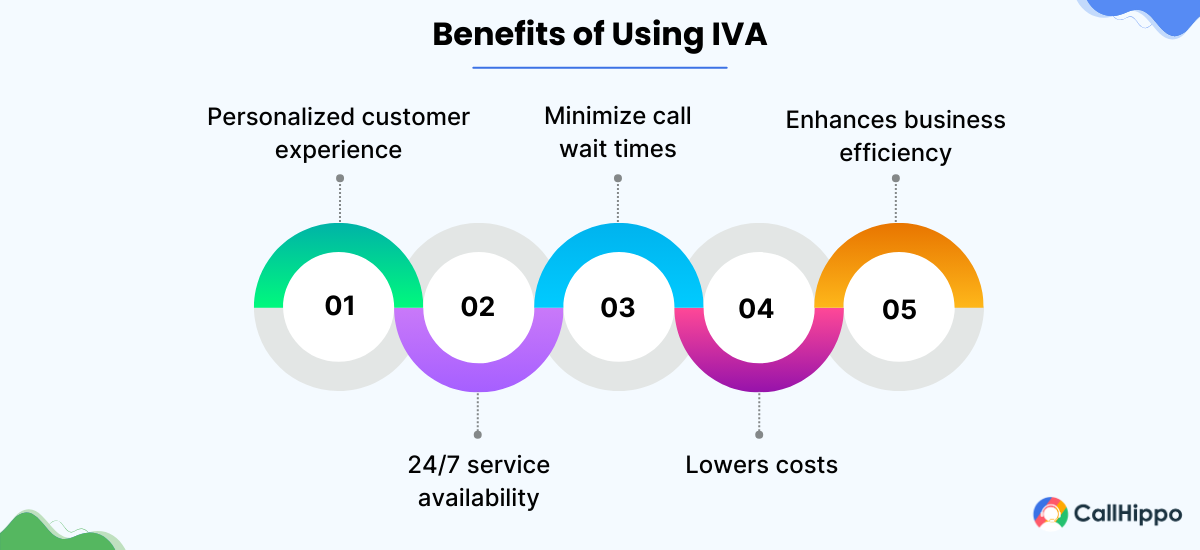
1. Personalized customer experience
Intelligent Virtual Agents listen to customer queries and sentiments and deliver personalized responses. By leveraging NLU, IVA helps businesses recognize different languages, speech styles, and dialects. Also, it uses customer data points and a knowledge base to offer personalized responses to customer queries.
All of these help businesses offer a highly personalized experience to customers, improve service quality, and secure their trust and loyalty.
2. 24/7 service availability
Mostly, agents work during standard business hours and may not be available to handle hours beyond the window. IVA in the call center sorts this problem to offer prompt responses even when a customer approaches the business beyond the standard working hours.
The self-service abilities help customers seek support irrespective of the differences in time zones or business hours. This helps businesses secure customer trust.
3. Minimize call wait times
Intelligent Virtual Agents can handle several customer inquiries at a time. So, customers do not have to wait for live agents to get information support or responses to their basic queries. Also, the IVA takes care of other tasks like translation, transcribing, data searching, updating the CRM database, etc. All these reduce customer wait times to ultimately elevate customer support quality.
4. Enhances business efficiency
As a virtual agent helps streamline high call volumes and automatically handles repeated requests, they reduce the agent workload. Agents can focus on solving complex queries that need real human attention and intelligence. With IVAs, businesses can handle many queries during a period. All these improve the efficiency of business communication.
5. Lowers costs
As IVAs can effectively handle customer inquiries, it reduces the need for live agents. Businesses can handle peak call volumes without investing in additional human resources. Also, IVAs improve customer satisfaction and retention rates. All these help lower business costs and achieve greater efficiency.
When to Use IVR?
IVR software works best if you are exploring ways to optimize call routing with agent workloads. They help answer basic support inquiries and achieve an efficient call transfer based on the specific needs of a customer. IVR systems also help businesses handle peak call volumes without hiring new agents.
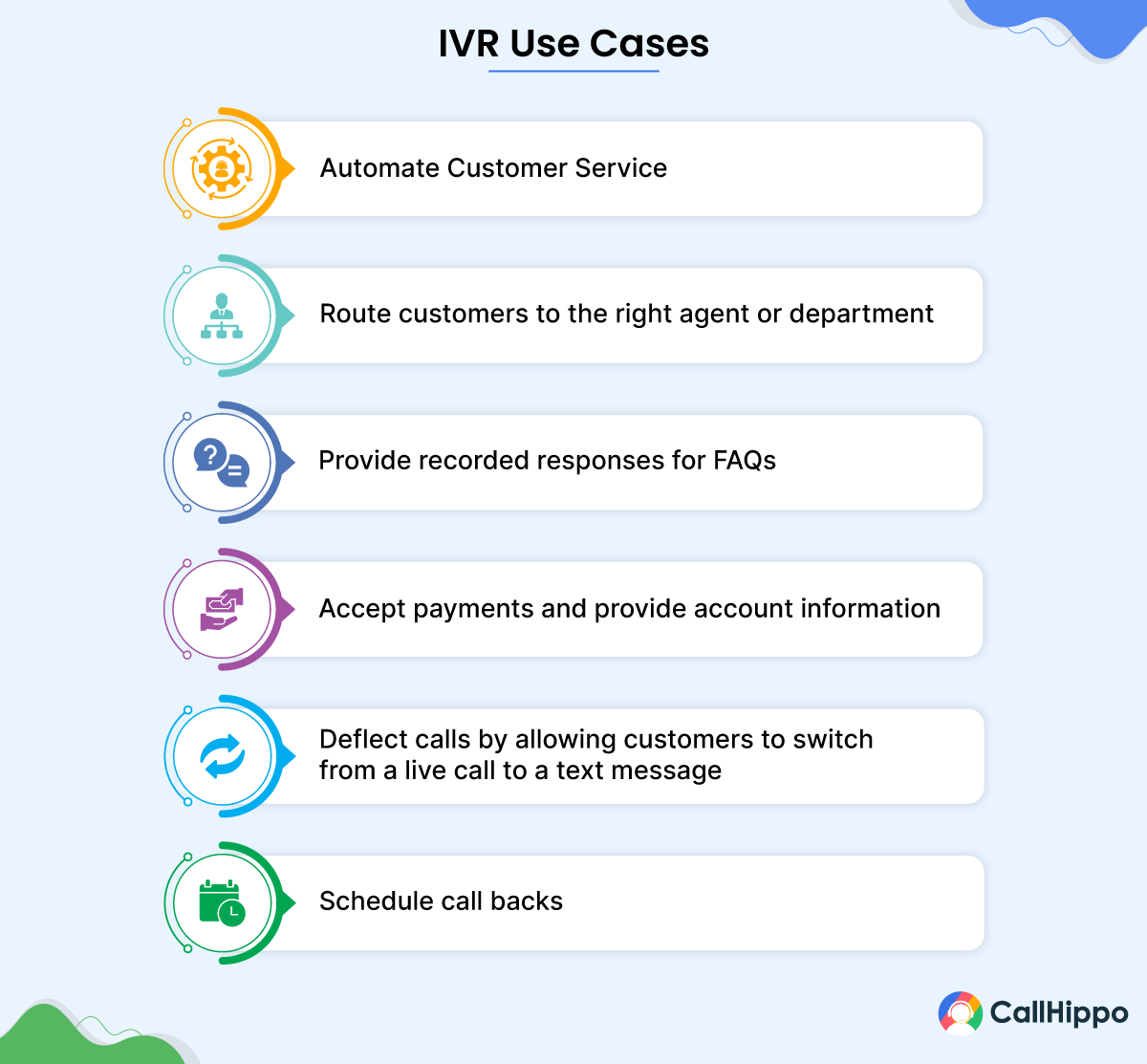
Beyond that, the IVR system can be customized with multiple menu options based on your customer behaviors and industry needs. It can also be tailored with a custom greeting message. All these add a professional image to your business. With a well-established look, IVR enhances the perceived value and trustability of the business among your customers.
Also, IVRs help save significant costs. Studies show that it costs $0.03 to $0.25 per minute when a call is handled by IVR, whereas it comes up to $3.00 to $6.50 when handled by a human agent.
IVRs are your go-to if achieving efficient call routing at affordable prices is the objective. They are a viable alternative to the traditional, standalone DTMF menus.
When to Use IVA?
Though IVR and IVA have different abilities, the best deal for a business would be to use both IVR and IVA.
IVA in call center helps automate responses to frequently asked customer queries. They can respond to customers even beyond the standard working hours. Your business may function between Monday to Friday following standard hours. In that case, if you wish to offer 24/7 customer service, secure customer trust, and not miss business opportunities, then using IVA helps.
If you are outsourcing after-hours customer support operations to another agency, you must consider investing in IVA. They are more accurate and affordable than the agencies. Businesses can also save the time and effort spent on training agents. IVAs help businesses handle several customer inquiries at a time. This trims down the staffing costs.
Start Free Trial with CallHippo IVR
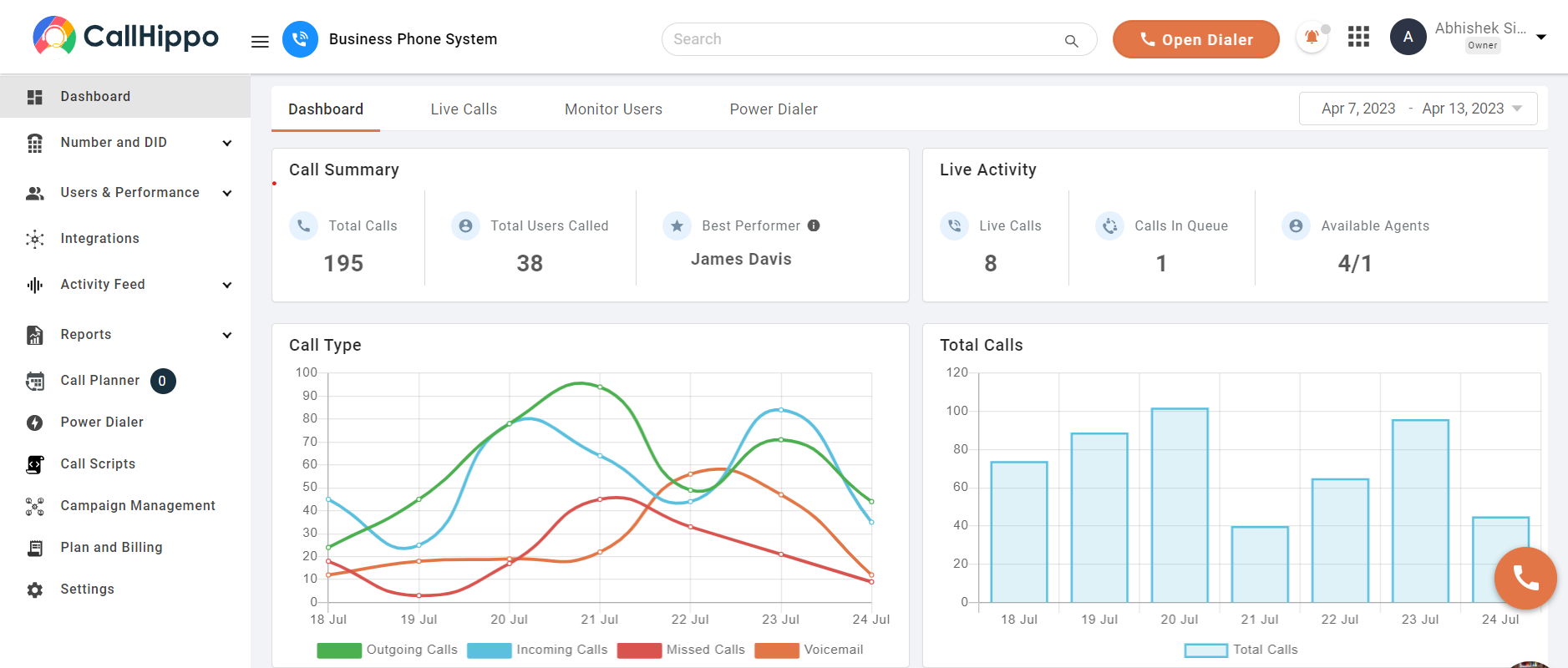
IVR systems are a more affordable option if you are endeavoring to achieve efficient call routing, boost your business image, and seamlessly handle peak call volumes. CallHippo is a popular call center software provider with a robust IVR system that helps scale your customer service quality to newer heights.
Everything about the CallHippo IVR, including the menu, sub-menu, greetings, etc. can be customized to a greater degree. IVRs can also be configured to deliver automated responses to frequently asked customer queries. Beyond IVR, CallHippo phone systems come with advanced call management features like call recording, call queuing, time zone expertise, call transfers, etc., that help businesses deliver superior customer service.
The best thing about CallHippo is that it has a free package that is affordable for small businesses. To experiment with the IVR system and experience its benefits hands-on, sign up for a free trial.

Subscribe to our newsletter & never miss our latest news and promotions.









